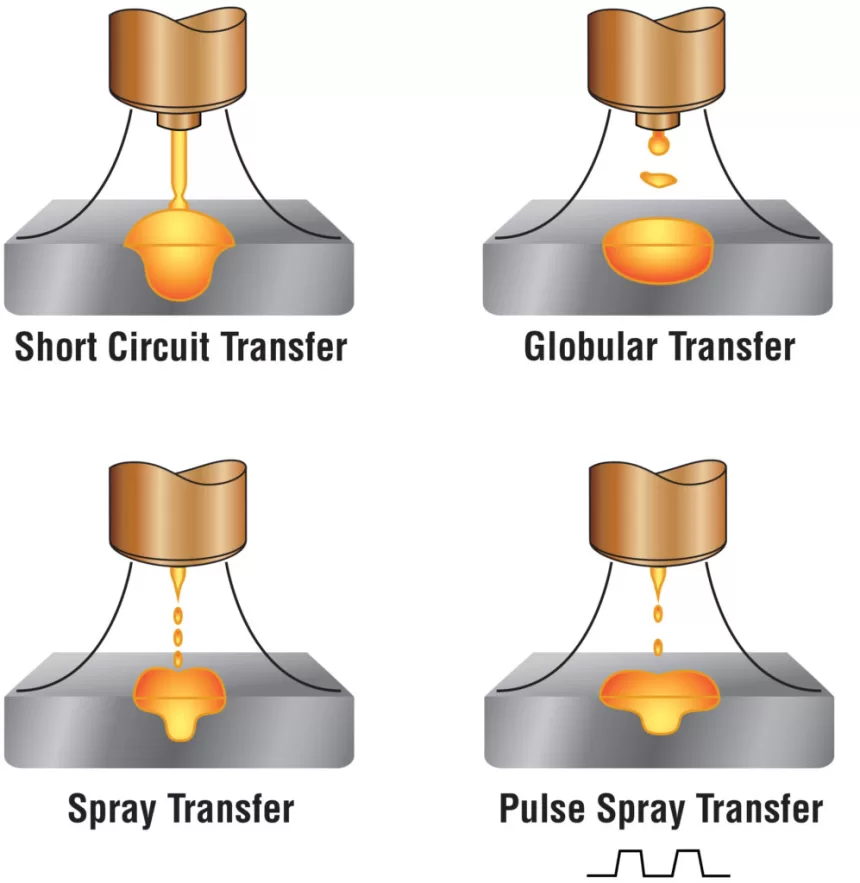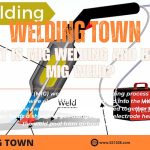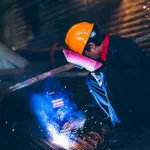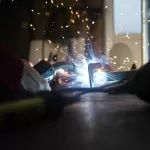Spray Transfer MIG Welding is an efficient and versatile welding process that has revolutionised the metal fabrication industry.
Spray transfer MIG welding is a highly efficient and versatile welding process that has revolutionized the metal fabrication industry.
Welding Town
Unlike other welding methods, Spray Transfer MIG Welding utilises a continuous stream of small molten droplets to join pieces of metal together, resulting in a stronger, cleaner weld.
In this article, we’ll delve into the intricacies of spray transfer MIG welding, exploring its principles, benefits and applications. Whether you’re an experienced welder or a curious beginner, this comprehensive guide will provide you with a clear understanding of this advanced welding technique, enabling you to tackle complex welding projects with confidence.

What Is A Spray Transfer In MIG Welding?
Spray transfer is one of the four primary metal transfer methods for MIG (Metal Inert Gas) welding, also known as Gas Metal Arc Welding (GMAW). It is a high-energy, controlled process that efficiently and accurately fuses metal parts.
The Spray transfer mode is characterised by the transfer of small droplets in a fine, controlled Spray pattern.
These molten droplets are propelled over an electric arc, similar to a fine mist of water sprayed from a hose nozzle. The high velocity of the droplets enables them to bridge the gap between the electrode and the workpiece, resulting in a stable and continuous arc.
What Do You Need To Achieve Spray Arc Welding?
During Spray transfer, the welding current is set relatively high, usually above 200 amps. This high current causes the electrode to melt rapidly, resulting in small molten droplets falling off the tip of the electrode. These droplets are pushed at high speeds into the weld pool by the electromagnetic force generated by the welding current.
Three key welding parameters are necessary to achieve spray transfer:
High welding current: Spray transfer requires a high current to ensure that small droplets are consistently dislodged from the electrode tip. This high current generates enough heat to melt the electrode quickly and continuously.
High wire feed speed: The wire feed speed must be set appropriately to ensure a steady supply of wire. This helps to maintain a stable arc and constant droplet separation.
Appropriate shielding gas: A shielding gas (such as argon or a mixture of argon and carbon dioxide) is used to protect the molten metal from atmospheric contamination. The shielding gas flows through the torch and surrounds the arc and the weld pool, preventing oxidation and ensuring a clean weld. In addition, a suitable shielding gas (e.g. carbon dioxide) increases the fluidity of the weld pool, resulting in higher welding speeds.
Advantages of Spray Transfer MIG
The spray welding transfer mode in MIG offers several advantages that make it the preferred choice for a variety of applications. Here are some of the key advantages of spray transfer:
High Deposit Rates: Spray transfer allows for high welding speeds and deposit rates. The continuous flow of small droplets ensures efficient material transfer, allowing welders to complete projects quickly and increase productivity.
Superior weld quality: Spray transfer produces high quality welds with excellent fusion and minimal defects. Controlled droplet transfer produces a smooth, uniform weld, ensuring a strong, durable joint.
Deep penetration: The high energy and heat of Spray transfer allows it to penetrate deep into the base material. This is particularly beneficial in thicker materials, resulting in strong welds and better joint integrity.
Minimal spatter: Spray-transferred MIG welding produces very little spatter compared to other metal transfer methods. Small droplets are easier to control, reducing the amount of spatter and molten metal adhering to surrounding surfaces, thus minimising post-weld clean-up.
Good weld pool control: Spray transfer provides excellent control of the weld pool, allowing the welder to control the shape, size and direction of the bead. This control is valuable for creating precise, aesthetically pleasing weld seams and for welding in challenging locations or tight spaces.
Versatility: Spray Transfer can be used on a wide range of metals, including carbon steel, stainless steel and aluminium. This versatility makes it suitable for a variety of applications in industries such as automotive, construction, manufacturing and aerospace.
Reduced Heat Affected Zone (HAZ): High welding speeds and the deep penetration of Spray Transfer result in a smaller HAZ, which minimises distortion and maintains the mechanical properties of the base weld metal.
Applications Of Spray Transfer MIG
Spray Transfer MIG welding is used in a wide range of applications, including:
Structural Fabrication: Spray Transfer is widely used in the fabrication of steel structures such as bridges, buildings and heavy machinery. Its high build-up rate and powerful welds make it efficient in large-scale projects.
Automotive manufacturing: Spray transfer is commonly used in automotive manufacturing to weld body panels, frames, exhaust systems and other components. It provides high quality welds with good strength and appearance.
Aerospace: Spray transfer is used in the aerospace industry to weld critical components such as aircraft frames, engine parts and fuel tanks. Its ability to produce high integrity welds is critical to ensuring the safety and reliability of aircraft.
Pipeline Welding: Due to its deep penetration and high build-up rate, spray transfer is often more suitable for pipeline welding. It is used in applications such as oil and gas pipelines, water systems and industrial pipelines.
Heavy Equipment Fabrication: Spray transfer is suitable for welding heavy equipment such as mining machinery, agricultural equipment and construction machinery. It provides durable welds that can withstand the harsh conditions of these industries.
Spray Transfer VS Globular Transfer
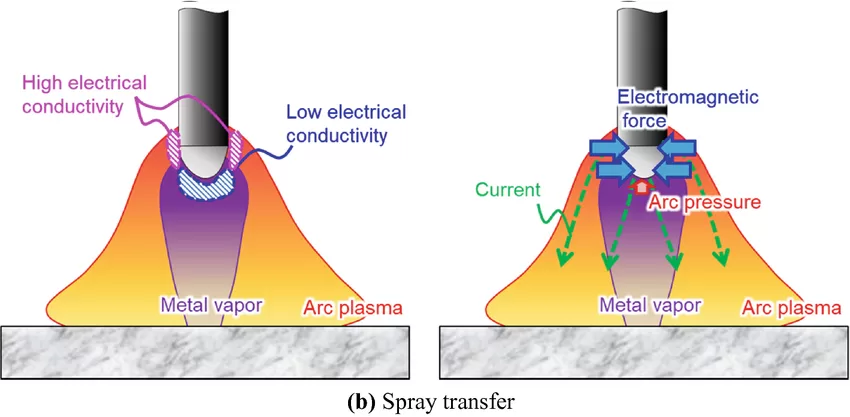 | 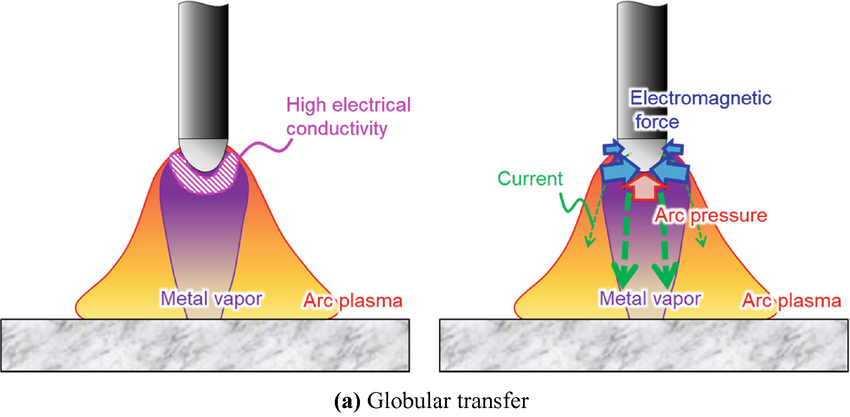 |
| Spray Transfer | Globular Transfer |
| Spray transfer involves the controlled transfer of small molten droplets from the electrode to the weld pool, whereas spherical transfer involves the transfer of larger droplets (larger than the electrode diameter) in a less controlled manner. In many applications, spray transfer is generally favoured over spherical transfer due to its superior weld quality, higher productivity and better control of the welding process. | Whilst ball transfer can be useful for welding thick materials, it generally produces more spatter and less control of the weld pool, compared to spray transfer which offers higher deposition rates, excellent weld quality, deeper penetration, less spatter and more flexibility than when welding in flat and horizontal positions only. |
Spray Transfer Vs Short Circuit Transfer
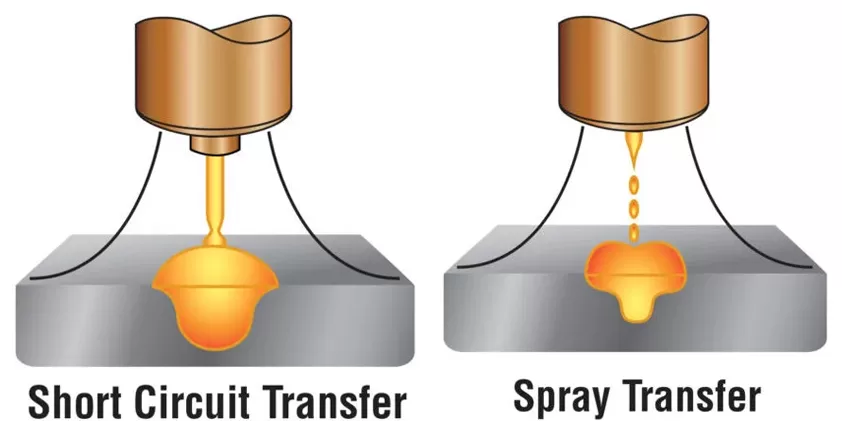
Spray arc transfer involves the continuous transfer of small molten droplets, whereas short circuit transfer involves the periodic transfer of larger droplets.
Although spray transfer provides higher productivity and better control, short circuit transfer is preferred for thinner materials and where lower heat input and reduced distortion are required.
Short-circuit transfer is suitable for thinner materials, provides better control of heat input, and generally produces less heat and distortion than spray transfer.
However, spray transfer is often used in applications that require high quality and high strength welds.
Spray Transfer Vs Pulsed Spray Transfer
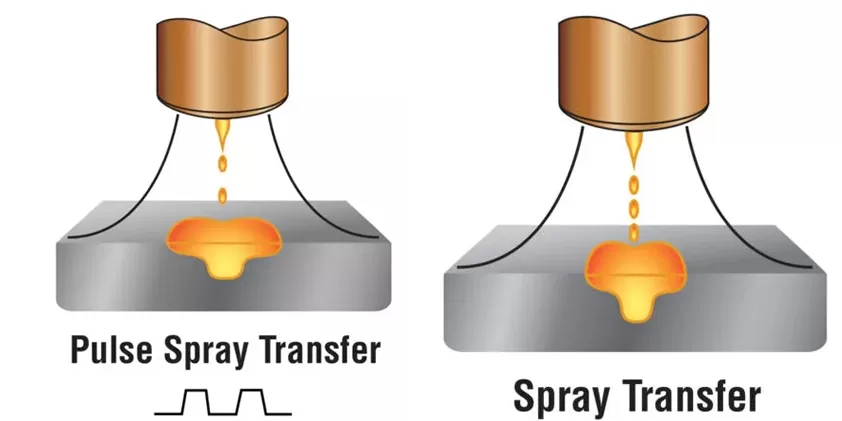
The selection of Spray transfer and pulse Spray welding transfer modes should be based on factors such as material thickness, desired weld characteristics, heat input control requirements and specific project needs.
Each mode has its advantages and considerations, and the selection of a welding process must be based on the needs of a particular application.
While Spray transfer is known for its high productivity and excellent weld quality, pulse Spray transfer offers advantages such as better control of the heat affected zone, reduced distortion and improved weld appearance. It is often more suitable for welding thinner materials, complex geometries or when aesthetics are critical.
On the other hand, pulse-Spray delivery involves alternating between high current levels (called peak current) and low current levels (called background current). This mode provides better control of heat input, reduces the risk of burn-through on thin materials and allows precise control of weld formation.
Drawbacks of Spray Transfer MIG Weld
Although Spray Transfer Metal Inert Gas Shielded Welding offers several advantages, there are also some disadvantages to the process:
Higher equipment costs: Spray Transfer Metal Inert Gas Shielded Welding typically requires high-end power supply welding equipment capable of providing the necessary high current and pulse control. As a result, initial equipment costs can be high compared to other welding processes.
Limited applicability on thin-walled materials: Spray transfer is more suitable for thicker materials due to its higher heat input and deeper penetration. It is difficult to control heat and avoid burn-through or distortion when working with thin-walled materials.
More sensitive to fit requirements: Spray transfer is more sensitive to joint fit and cleanliness than other welding methods. Defects in joint preparation or fit-up can lead to porosity, lack of fusion or other defects.
Increased shielding gas return consumption: Continuously sprayed molten droplets require higher shielding gas flow rates to adequately protect the arc and molten weld pool. This can lead to increased shielding gas consumption compared to other transfer methods, thus increasing operating costs.
Limited welding positions: Spray transfer metal inert gas shielded welding is more challenging in certain welding positions (e.g. top or vertically upwards) due to higher heat input and melt drop propagation. Special techniques or equipment may be required to achieve satisfactory results.
Conclusion
Spray transfer in MIG welding is an efficient and versatile process that brings numerous advantages in terms of productivity, weld quality and control. Continuous injection of small molten droplets allows for high deposition rates, excellent fusion and deep penetration, making it suitable for a wide range of applications in a variety of industries.
While there are some drawbacks to Spray transfer MIG welding, such as higher equipment costs and limited adaptability to thin materials, these challenges can be mitigated with the right training, technical improvements and careful parameter selection.
With its ability to produce strong, clean and precise welds, SprayTransfer MIG welding has become the preferred choice for demanding projects in structural fabrication, automotive manufacturing, aerospace and more.






